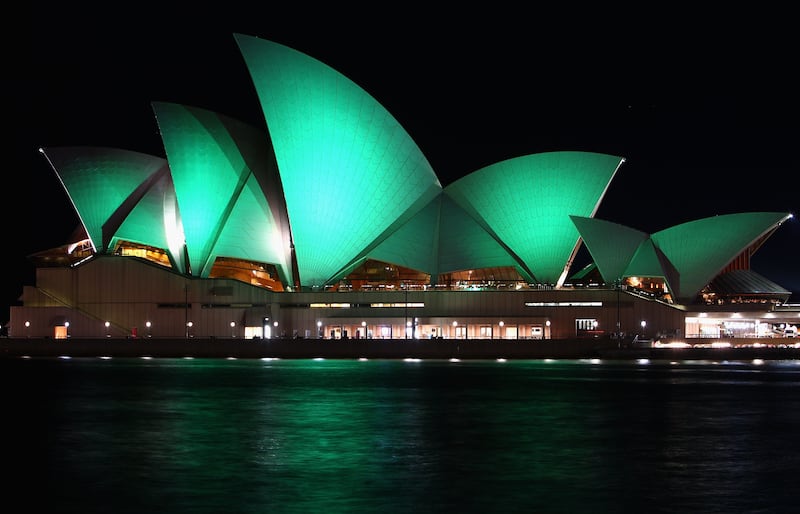Billy Cantwell: Don’t cringe about Ireland’s shamrock empire, nurture it
When the Sydney Opera House was first bathed in green light to mark St Patrick’s Day in 2010, an unforeseen problem emerged. The view from the official function, at which dignitaries would watch the famous sails turn green from the other side of Circular Quay, was obscured by the unexpected arrival of an enormous cruise ship.
Brows were furrowed. Solutions imagined. Calls made.
As if by magic, the cruise ship shifted its berth by the length of Grafton Street to allow the VIPs an unimpeded view of the spectacle – it turned out an Hibernophilic minister in the NSW government was the hero. The potency of Ireland’s soft power was confirmed.
This same force will see Taoiseach Leo Varadkar feted by another Hibernophile at the White House this week. It is an annual ritual that sparks a cultural cringe. But while some sneer and gag at the schmaltzy bowl-of-shamrock ceremony, the event represents a level of access that most countries – including the one where I live, Australia – would kill for.
READ MORE
Perhaps the cringe is borne of a collective memory from a time when a more culturally insecure Ireland craved validation. Or does it point to enduring discomfort about perceived Quiet Man fantasies of the diaspora?
In truth, for a couple of days each year, Ireland resembles a global superpower. No small thing for a small country. To not send Ministers all over the planet in March – as popular as that might be in Ireland – would be a missed opportunity, and a mistake.

Ireland never craved an empire, but it has got one. As Paul Keating said when he addressed the Dáil as Australian prime minister in 1993: “Ireland is possibly unique in the world in the hold it has on the consciousness of other countries.”
This is the real power of St Patrick’s Day. The world quite likes us. This is an affection that has little to do with politicians. It has been generations in the making: a gift from the past, a legacy of the sweet sorrow of emigration.
Australia is an excellent example of where Ireland could, and probably should, do more – culturally, economically and politically – to supercharge this goodwill. A new Irish consulate is to open in Melbourne but Australia remains something of an afterthought at Iveagh House.
There are practical and sentimental reasons to nurture the bilateral friendship. At least one in three Australians is of Irish, eh, distraction. (Aussie humorist John Doyle once observed that during his first visit to Ireland, he “couldn’t believe how Australian everyone looked”.)
Australia is the world’s 12th-largest economy, located in the planet’s fastest growing region.
St Patrick’s Day should never become simply a chance for Ireland to flog its wares. It’s up to Ireland to nurture its empire, not just exploit it. But there’s another emerging strand to the cultural cringe, unconnected to the diaspora.
St Patrick’s Day is a celebration of Irish nationalism. As the country confronts new forms of aggressive xenophobia, it would be alarming to see the national day hijacked by the “Ireland is full” mob. If March 17th were to become a lightning rod for a narrow definition of Irishness – as we see here with Australia Day – we might find the world does not like us quite so much.
The Sydney Opera House will not be bathed in green light this year. It’s not a snub. The NSW government has, for budgetary reasons, decided to scale back the use of the famous sails. Besides, Tourism Ireland decided last year that lighting up buildings might not be the best look during an energy crisis. But if there were an Irish problem to be solved, a call might be made to the Australian prime minister Anthony Albanese. He’s half Irish you know.
Billy Cantwell is deputy opinion editor at the Sydney Morning Herald. He was the founding editor of Australia’s Irish newspaper, The Irish Echo.
Finn McRedmond: With an uglier nationalism on the rise across Europe, Ireland ought to think carefully about the vision it projects
It has become rather banal to point out that Ireland wields soft power far greater than its size. “On a per head basis” the Economist reckons, “Ireland has a good claim to be the world’s most diplomatically powerful country.” Thanks to some well-crafted reputation laundering after the financial crisis, the marriage and abortion referendums of the 2010s, the enthusiasm of Irish-Americans, and Joe Biden’s loud Hibernophilia Ireland is enjoying a prosperous moment in its public relations.
St Patrick’s Day is the annual centrepiece of Ireland’s long-running PR campaign. It is telling that the primary image it conjures is not of Dublin but of the United States: the parade in New York, the Chicago river dyed a lurid green, the Taoiseach’s hearing with the US president, the exchange of shamrocks, Bono’s weird poem in 2022. The Irish version – boozy Dublin streets and rural parades of tractors – is a pale imitation of the true nature of the holiday. This is a testament not just to the proud Irish diaspora and the robustness of an Irish-American political culture; it is also proof that St Patrick’s Day is a global marketing event and, for now, a rather successful one.
It is unusual for any nation to have such global exposure on their national day. St David’s Day doesn’t see the first minister of Wales offered red carpet treatment in Washington DC, for example. This is vibes-based diplomacy: shamrocks, green ties, poems, the Dropkick Murphys, the woolly notion that Ireland is a nice place full of nice people. The holiday may lack nuance, but St Patrick’s Day has been so successful at disseminating a positive vision of Irishness that the country is even forgiven for myriad flaws: Ireland’s vibes are so strong that it is celebrated for only affording full reproductive rights to women in 2018, rather than scrutinised for the fact that it took this long.
So there is a strong case to be made for St Patrick’s Day as a politically expedient and slightly cynical moment of realpolitik for Ireland. It helps that Biden truly believes he is Irish; and that the Democrats see peace in Northern Ireland as part of their legacy. But while they may be happy to roll out the green carpet on March 17th every year, not everywhere is as tolerant of such flagrant and kitschy displays of national stereotype. A green river might wash in Chicago but in London it would irritate most and enrage a few. On St Patrick’s Day Ireland must be careful to remind itself: America does not think like the rest of the world.
[ Remembering Dropkick Murphy, the fighting doctor hailed by drunks and punksOpens in new window ]
In London, for example, St Patrick’s Day passes with little notice. Ireland does not loom large in the psyche nor in the political architecture. This is true even in spite of the millions of emigrants – many with much closer ties than the casual Irish-American. London is not a place where emphasising any national identity has ever worked particularly well. And Ireland is not a special case, no matter the grá of the Americans.
For total diplomatic success Ireland needs to calibrate its PR campaign to the spirit of the place. It is not in the character of the English to indulge in bawdy displays of nationalism – contrary to the erroneous assumption made by many in Ireland. Brexit wasn’t really a nationalist project, St George’s Day isn’t even a holiday. The artefacts of Englishness are hard to conjure – there is no equivalent to Ireland’s green shamrocks and harps. The art of English understatement demands something very different from Ireland on its national day: a quietly confident display of civic nationalism that reflects the country’s cosmopolitan, fair-minded outlook.
This is a far cry from the Biden-ification of Irish-American political culture. But to appeal to Britain, Ireland must think like the British. And with an uglier nationalism on the rise across Europe, Ireland ought to think carefully about the vision it projects: a braggadocious, narrow and kitschy self-styling has long fallen out of contemporary tastes.
Finn McRedmond is an Irish Times columnist
- Listen to our Inside Politics Podcast for the latest analysis and chat
- Sign up for push alerts and have the best news, analysis and comment delivered directly to your phone
- Find The Irish Times on WhatsApp and stay up to date













